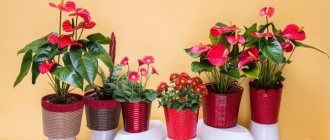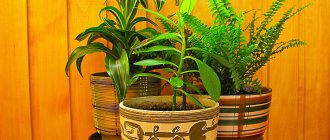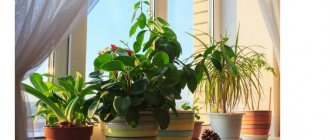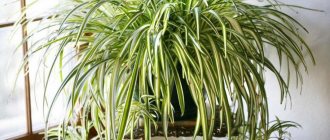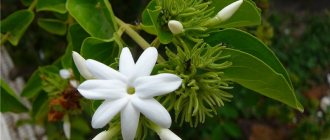The oxygen released by flowers also helps the brain work more actively, improves memory and concentration. Therefore, putting an ornamental plant on the desk of an adult or schoolchild is a great idea. Choose flowers with lush foliage: e.g. chamedorea
.
Citrus trees
will also be useful on your desk : their light aroma helps improve memory, activates brain function, improves immunity and improves mood.
Normalize air humidity
Houseplants are excellent humidifiers. Dry air is harmful to the skin and lungs; in such a room you get worse sleep and get sick more often. That is why during the heating season (and in our country this is most of the year), when the air in apartments is dry, indoor plants will become a real salvation. Some varieties can increase the humidity in a room by 10–15%. Succulents are considered one of the most effective “humidifiers”
,
dipsis
and
aloe
. They are able to retain moisture in their stems and leaves, and then gradually release it into the air.
Complement the interior
Plants in the house help create a complete interior image. Even the most fashionable modern designers cannot do without this natural decor. In addition, flowers create coziness and mood, can be a stylish accent and the main character of the room, or modestly occupy small niches and window sills. Choose flower pots to match the interior or choose an unusual flowerpot, create a full-fledged green area or limit yourself to a couple of simple cacti - everything is in your hands.
Feng Shui
According to ancient Chinese teachings, plants in a house carry special energy, which has a direct effect on its inhabitants.
Lemon
A lemon tree is a symbol of good luck, and a fruit-bearing plant is a sign of abundance and wealth. It increases the thirst for knowledge and activity, so it is especially recommended to keep it in the room where children study and play.
Lemon requires annual replanting, as its root system grows very quickly. Loves diffused lighting, absence of drafts and constantly moist soil.
Crassula or Crassula
Indoor plants: choose for yourself and your loved ones
Aloe
This is a well-known home healer. It will help with colds, inflammation, can stop bleeding and heal wounds. Its juice is used to treat throat, heartburn, gastritis, gum inflammation and other diseases. It is often used for cosmetic purposes.
Chlorophytum
It is also very useful to keep in the house. This is a bushy plant with thin and bendable leaves that have light stripes. It will help get rid of moldy fungi and pathogenic bacteria, and cleanse the air of harmful substances present in it. Chlorophytum will bring peace and comfort to your home.
Peppermint
Great for growing in a pot on a windowsill. It improves appetite and stimulates the digestive process. Its leaves are good to use as a seasoning for various dishes and to brew tea with them.
Violet
Many people’s favorite plant will fit perfectly into the kitchen interior and will not take up much space. Violet will clean and humidify the air from carbon monoxide. This flower is a symbol of peace and tranquility in family relationships. It is believed that white flowers help get rid of sadness, fatigue and depression. Blue violets are suitable for creative people. They give peace of mind, stimulate spiritual growth and strengthen character. Flowers of red and pink colors lift the spirits and can protect their owner from diseases.
Ficus
It does an excellent job of collecting dust that settles on its leathery leaves. They are very easy to wash or wipe with a damp cloth. Ficus will saturate the room with oxygen and cleanse the air of unpleasant odors. It improves family relationships, calms and relieves anxious thoughts.
Lianas
A beautiful vine, for example, scindapsus, looks good in a hanging pot. It has green, heart-shaped leaves with yellowish spots. It is unpretentious and perfectly purifies the air. Scindapsus transforms lazy energy into activity. It can be placed in the kitchen.
Wax ivy
It is a climbing flower with hard, oval-shaped leaves. It has white, pink or red umbrella inflorescences. The plant neutralizes negative energy in the house, protects the owner from troubles and cleanses the air of germs.
Geranium
Lush curly geranium has many healing properties. It repels moths and evil spirits, relieves irritability, normalizes sleep and fights pathogenic bacteria. Her mere presence in the house attracts good luck and fulfillment of desires. The aroma of these flowers relaxes and relieves headaches. If the plant withers, they believe that one of the household members may get sick.
Crassula
This plant can be squat or tall, with a thick trunk. It is often called the money tree. Crassula has small dark green leaves that are arranged symmetrically on the branches. They look like little coins. Therefore, it is believed that the fat woman is capable of attracting material wealth into the house.
Sansevieria (mother-in-law's tongue)
Quite a tall plant with massive elongated leaves. They come in one color and are dark green in color. They also have light stripes in the middle or white spots. The flower improves family relationships and brings harmony. Its leaves are antiseptic, which is why they are widely used in folk medicine. Sansevieria juice is used to heal wounds, and the plant can also stop bleeding.
Oxalis
This bushy plant has a purple color. Its leaves resemble a flock of butterflies. During flowering, small white umbrella flowers appear on it. The branches of the flower can intertwine with each other. Oxalis leaves can be used in cooking, for example, added to salads. They taste like sorrel. The plant improves intuition and sharpens the senses. It can be held by those who want to meet their soulmate and attract attention.
Cactus (Echinopsis)
It has a spherical, slightly elongated shape. Its ribbed body is covered with small needles. If you take good care of the cactus, it will bloom towards the end of spring. And every year a shaggy soft arrow will appear on it, from which a bud with a wonderful aroma will then open. It will bloom for up to 3 days. The cactus is placed near the TV or computer and in other places with dangerous radiation.
Citrus
All citrus fruits calm the nervous system and relieve stress. A tree can be grown from a lemon or tangerine seed. The leaves, just like the fruits, can have beneficial effects. Plants secrete essential oils that help calm, relieve stress and fatigue, and ensure healthy and sound sleep.
Myrtle or eucalyptus
These plants are perfect for the bedroom. Their leaves secrete substances that make breathing easier and relieve bronchospasms. It is very useful for people suffering from asthma and respiratory diseases.
It is customary to give myrtle to newlyweds as it is a symbol of long and happy family relationships. It needs to be carefully looked after so that the plant does not die and take away its well-being.
Araucaria
Thanks to her, the room will be filled with the freshness of a coniferous forest. It is a miniature pyramidal shaped tree with soft needles. The plant perfectly purifies the air.
Spathiphyllum
Many flowers, according to signs, bring harmony and love to the house. For example, spathiphyllum is a symbol of female happiness. He helps the girl in search of her soul mate and saves the relationship of the married woman.
Aichrizon
This is a small 30-centimeter plant with heart-shaped leaves that will make its owner happy and bring her good luck in love.
Dwarf pomegranate
It is believed that its fruits can strengthen marital relationships if husband and wife try them together.
Anthurium
It is recommended to place red flowers in the bedroom. They bring harmony and mutual feelings into the life of a married couple. Anthurium has glossy, dark green, heart-shaped leaves. According to legend, this flower will bring good luck to its male owner. Anthurium is a symbol of courage, masculine strength, passion, desire for freedom and love.
Calla
It has long leaves and single curled flowers. It protects the home and generates joy and goodness, and also transforms negative energy into positive.
Camellia
Red camellia will help refresh your relationship. Its inflorescences look like peonies. The plant brings success in creativity and career.
Kalanchoe
It has small inflorescences of different colors. This is a real home healer. The flower heals cuts, treats colds, regenerates skin, relieves stomach ulcers and even varicose veins.
Cyclamen
An indoor plant with dark matte leaves with white inclusions. Cyclamen inflorescences resemble butterflies; their shade can vary. Most often, one shade smoothly transitions into another. Flowers have strong energy. They help get rid of fears, depression, bad dreams.
Calathea
This is a flower with large oval leaves on which a grooved pattern is applied. During flowering, small white or yellow flowers appear. The flower purifies the air well and absorbs negative energy. Signs suggest that calathea creates a peaceful atmosphere in the family.
Plant and grow plants and flowers at home, and the atmosphere around you will be filled with positive energy and pleasant aromas!
What flowers attract good luck
The list of indoor plants that bring good luck includes hibiscus (Chinese rose). This plant of passion, in addition to good luck, brings peace and harmony to the family.
Myrtle is the best gift on your wedding day. Mutual understanding between spouses brought by the myrtle tree – isn’t that good luck?
Chlorophytum is such a simple plant, known since childhood. This flower is a must-have in a crowded office. It will save the team from quarrels and gossip. Chlorophytum perfectly purifies the air and absorbs unpleasant odors.
Anthurium is called man's happiness by many. They say it restores potency, so it should usually be placed in the bedroom. In addition, thanks to the shape of the flowers, which resemble a heart, the plant brings happiness and idyll to the family.
Cacti help protect yourself from thieves, which is undoubtedly good luck . Cacti are also considered money magnets. They love bright light and are undemanding when it comes to watering.
Flowers that attract love
When love and harmony reign in a house, they say that the owners of this house are prosperous and lucky. Therefore, often indoor plants that bring good luck and prosperity provide their owners with success in love affairs.
Spathiphyllum is considered women's happiness . A noble plant with a gentle character should definitely help in producing offspring.
The delicate Hoya is usually planted in the bedroom of spouses; it maintains relationships and protects peace.
orchid attracts love . It will be much easier for owners of a tropical guest to find a couple.
By moving pansies from the garden into a pot , you can rest assured that your relationship will be faithful. These flowers relieve stress and fatigue, attract happiness and love.
Plant according to zodiac sign
Star patrons influence a person's character. Including the ability to handle a green pet. What is useful to one will irritate another. It is advisable to take into account the zodiac constellation when choosing.
Specification:
- Aries loves bright colors. The girl and the guy need to cope with enormous energy potential. Helpers in this difficult task are begonias, roses, and azaleas.
- Taurus hates cheap simplicity. He likes a varietal lily in a charming, original pot.
- Gemini will be delighted by the orchid. And the fickle ladies of the sign will fall in love with the spreading palm tree.
- Cancer is a traditionalist. Kalanchoe and aloe are ideal.
- Leo is greedy for royal appearances. Please your friend with camellias and blooming roses.
- Virgos are practical and enterprising. They have no time to bother with feeding. Unpretentious chlorophytum or lemon will do.
- Libras are followers of the ideal, sophisticated style. But they will be delighted with the common violet.
- Scorpio is burdened with a burden of difficult energy. Azalea will soften his strict temper.
- Sagittarians prefer artificial flowers. And a lover of botany will be delighted by the exotic. For example, indoor lemon with fruits.
- Capricorn has no time to deal with complex care. They prefer to acquire ficuses or Decembrists.
- Aquarians are always in dreams. It will stimulate the imagination of the representative of the arrowroot sign.
- Pisces are prone to beauty in everything. Choose a pet for them, strewn with flowers. For example, azalea.
How to choose home flowers for your apartment
Before choosing indoor plants, keep in mind that even the most beautiful and healthy flowers from the best suppliers will not grow if the conditions in your apartment are not suitable for them. Like all other living things, houseplants have certain requirements for the environmental conditions under which they can thrive.
Plants are “suitable” for your apartment if you can provide them with the light and temperature conditions they need. Choosing a suitable location plays a decisive role in the life of indoor plants. If you know the basic rules for placing plants in an apartment and the requirements of various types, you will not buy a plant that is not suitable for your apartment. And now some tips that will help when buying plants.
To choose the right indoor flowers for your apartment, analyze the location of the windows.
Windows facing east and west. Those lovers of indoor plants whose apartments have windows oriented to the east and west are very lucky: they can buy (almost) everything they like in a flower shop, since most indoor plants love a well-lit place, but cannot stand direct rays midday sun. They need just the kind of lighting that they get through windows facing east and west.
And even those plants that prefer bright sunlight or, conversely, love a shady place, grow well on windows illuminated by the rising and setting sun. True, they do not achieve such optimal development here as on the ideal southern or northern windows.
Windows facing north. If you are looking for plants for a north-facing window with low light, choose decorative foliage species such as:
Fern
Philodendron
Sansevieria
Dracaena
Ficus
Windows facing south . This is an ideal place for luxuriously blooming tropical plants:
Bougainvillea
Hibiscus
Strelitzia
For exotic species, such as Anona reticularis.
Such plants require constant attention and care. Before choosing flowers for your apartment, find out about their origin.
The plants collected on your windowsill or crowded into the window of a flower shop come from many different areas of the globe.
For example, many cacti and succulents are native to arid, desert regions. They are used to bright sunlight, so they need to be given a warm, sunny place.
Ferns are native to damp tropical forests, so they prefer diffused light, similar to that which penetrates the foliage of tall trees in places where these plants naturally grow.
Species originating from the tropics, for example:
Maranta
Croton (Codiaeum) are accustomed to uniformly high temperatures throughout the year.
Subtropical plants, such as Reed (Scirpus cernuus) , some dracaenas and palms, have adapted to different seasons with high temperatures during the growth period and lower temperatures during the dormant period.
Plants of European origin, from temperate regions, are rarely found among indoor crops.
From the Mediterranean regions came to our rooms:
Bluebell (Campanula)
Gelksina or Soleirolia (Soleirolia soleirolii)
And the well-known primroses come from China as weeds in rice fields.
Another tip on how to choose indoor flowers is to pay attention to their leaves.
Fleshy leaves. Plants require bright lighting and are tolerant even of direct sunlight. Example: Sansevieria.
Leathery or waxy leaves. Plants tolerate dryness well. Example: rubber plant (Ficus elastica).
Large, soft leaves. Plants prefer a semi-shaded place. Example: indoor linden, or parmannia (Sparmannia africana).
The leaves are variegated or patterned . Plants need a well-lit place. The more white spots and streaks on the leaves, the brighter the sunlight should be. Example: croton, or codiaeum.
Spikes or pubescence. Plants are tolerant of sunlight. Example: cacti.
Small leaves. The ideal place for plants is sunny. Example: Mil's milkweed (Euphorbia milii).
Large leaves collected in a rosette. Plants do not tolerate bright sunlight. Example: Usambara violets (Saintpaulia ionantha, hybrids), streptocarpus (Streptocarpus, hybrids).
Unfortunately, there are exceptions to these rules. But most species correspond to the given characteristics.
If the plant is not “suitable” for your apartment, of course, it is within your power to slightly change the conditions in accordance with the needs of the plants. For example, you can install artificial lighting devices or an electrical installation for air humidification.
Undoubtedly, all this requires a lot of hassle and does not always create optimal conditions for plants.
Sometimes it happens that you are simply in love with a plant that is completely unsuitable for the conditions in your apartment. In this case, my advice to you is: experiment! But keep in mind that your joy in success will be short-lived, especially since such problematic plants are not cheap. If, 4 weeks after purchase, a bell worth several marks dies, this is a nuisance for you, but it is easier to bear than the loss of an expensive camellia.
Buying indoor flowers: how to choose the right plants in the store
The first step to success is purchasing the right indoor plants. Proper care of flowers begins when they are purchased. If you choose the right store, plants and timing of purchase, and then allow the new plants to adapt well to the existing conditions, then you are unlikely to have problems. The decisive factor for choosing plants is the ability to provide them with a place in the apartment that meets their requirements.
It is not at all necessary to choose flowers for your home in a chic, expensive store in the city center. There are many small shops and benches somewhere around the corner, in the market, there are special departments in supermarkets, and gardening centers are organized on the outskirts of the city. The main thing is to look carefully at where they take good care of the flowers, pay attention to them, and spare no effort. So, choose the right indoor plants!
Flowers are poorly cared for if:
- Withered leaves
- The tips of the leaves are wrinkled or cut off,
- The pots are dirty,
- The soil is too wet or dry.
In this case, it is best to go to another store.
Signs of good care:
- Plants are green, strong, well developed,
- There is enough space in the pots for further growth,
- There is a label with the name of the plant and care instructions. However, these little plastic labels often get lost, which is why some large flower growers print the name and instructions directly on the plastic pot. This is not a bad idea, although the inscription only lasts until the first transplant. But during this time you will become perfectly familiar with all the techniques for caring for the plant.
Ask the store for specific plants. If they are not available, the store owner will deliver the necessary types for you from the wholesale market or from suppliers within 2-3 days.
When purchasing indoor flowers during the cold winter months (such as poinsettias, which are only available during this time), you should ask the seller to package the purchase well - first in silk paper, then in newsprint. In summer, silk paper will protect the plant from the bright, burning sun and prevent too much evaporation.
Houseplants can sometimes be ordered from gardening companies and sent to you by mail. However, you cannot inspect the plant in advance; you must choose exactly what you need from the catalog and receive what they send to you.
Of course, you have the right to make claims to the company, for example, to send back diseased copies. Typically, plants are sent by mail in special packages in which they do not wither for several days.
But if your package sits in the mail, the plants will suffer. Most often, rare hybrid or exotic cultivated species are ordered by mail.
But if you are not interested in something special or rare, buy plants from local flower merchants.
Which ones are better not to have in the house?
When buying indoor flowers, we, as a rule, do not think about how they affect human health. Their appearance and how they fit into the interior are important to us. However, when our pets get sick, or we start to feel unwell, we consider all the possible causes of this condition.
Among the representatives of the flora there are many poisonous specimens. Sometimes, the most beautiful of them are absolutely unsuitable for growing in residential areas.
Harmful for adults and children
The most harmful indoor flowers for humans are:
- spurge. Representatives of the Euphorbia family look quite exotic, thanks to their rich, large leaves. Today, more than 3,000 species of plants of this genus are known. Some of them look like palm trees, others look like cacti. Most species have poisonous spines, so their injection is poisonous. The stems and foliage of milkweed contain white juice, which, when entering the human body, causes poisoning. Upon contact with skin, irritation and burns occur;
- azalea. A luxurious flower, loved by gardeners. Its large flowers have many shades, so azalea is often used to create compositions. The plant is poisonous; its foliage contains substances that, when ingested, cause nausea, poisoning and even convulsions;
- oleander. This beautiful member of the Kutrov family grows in regions with tropical and subtropical climates. Flower growers grow only a few of its species. The flower can cause dizziness, severe attacks of nausea and fainting. Oleander juice is so poisonous that it causes burns and allergic reactions on the skin. If it gets on the mucous membrane of the eye, there can be serious consequences, including partial loss of vision;
- croton Externally, the flower resembles a lush tree crown. At home, flowering is extremely rare, but the incredible color of the leaves attracts with its beauty even those who are not involved in growing home flowers. Croton is poisonous. If its juice gets directly into the wound, it can be fatal. Places where juice comes into contact with the skin should be thoroughly washed with soap and alkali (laundry);
- cyclamen. One of the favorites of gardeners, it has a large palette of unusually shaped flowers on high stalks. Cyclamen leaves are no less attractive, but at the same time toxic. Cyclamen tubers also pose a considerable danger; they contain a poison similar to that of curare. If it enters the esophagus, it will provoke diarrhea, dizziness, cramps, gastrointestinal pain and loss of consciousness;
- Gloriosis. This exotic specimen is unique and is capable of changing its shade several times during the flowering period. Despite its attractive appearance, Gloriosa is toxic, and all its parts contain deadly poison. If the family has children and pets, you will have to give up growing this flower. Once in the gastrointestinal tract, it causes intoxication and, as a result, kidney failure;
- monstera. Due to the large size and unusual shape of the leaves, Monstera decorates offices and various public institutions, but flower growers often grow it at home. Monstera juice, when it gets on the skin, causes severe burns, itching, and allergic reactions. If it comes into contact with the mucous membranes of the eyes, vision is severely affected. If a child accidentally eats even a small piece of leaf, inflammation of the stomach and intestines is possible.
When choosing indoor plants, you need to carefully study the information about whether the flower you like is harmful or not.
Dangerous for animals
Pets, like people, are susceptible to harmful plants. Most often in residential premises you can find the following indoor flowers:
- ivy. Evergreen ivy belongs to the Araliaceae family, which includes more than a thousand species. The entire flower is poisonous: stems, foliage and even the root system. This plant is liana-like, which attracts kittens who try to climb up it. Ivy is no less dangerous for people;
- Dieffenbachia. This specimen attracts attention with the beauty of its leaves with an unusual variegated pattern. Its juice, when it gets on the skin, causes itching, redness, and in some cases, a burn. When it comes into contact with the mucous membranes of the gastrointestinal tract, it provokes a burn or severe poisoning. The presence of pets in the house excludes the cultivation of Dieffenbachia;
- alocasia. One of the most beautiful indoor flowers, but it is dangerous for both pets and people. All parts of the plant are poisonous, including the root system; they contain mercuric chloride - deadly hydrocyanic acid and mercury. Therefore, all work on transplanting alocasia should be carried out wearing protective gloves. If the roots are accidentally damaged during replanting, then all measures must be taken to avoid inhaling this smell.
When planting dangerous plants, it is worth knowing that even pollen in the air can cause an allergy attack. Therefore, you need to be extremely careful when choosing indoor flowers. If you have small children and animals at home, you should not purchase specimens that you are not sure are harmless. You need to opt for healthy plants.
5/5 — (1 vote)
Fluffy asparagus
Asparagus is a very beautiful branched plant that, with proper care, grows quickly and pleases the eye with bright greenery. This plant loves watering, but do not allow water to stagnate in the soil. In addition to regular watering, it is better to spray it with a spray bottle and carry out water procedures. Protect the plant from pests and diseases.
It was this flower that once turned the scientific world upside down, giving it the first studied amino acid - asparagine. The plant is eaten, used in folk medicine, and used to decorate rooms.
Among its useful properties we note:
- purifying the air from pathogenic bacteria, fungi, mold, heavy metals, dust;
- when used internally, it allows you to cope with various diseases, including stone formation, anemia, problems with the gastrointestinal tract and allergies.
Asparagus berries contain dangerous substances that can harm both people and animals. Therefore, try to hang or place the plant so that no one decides to eat the colorful berries.
Crassula
Crassula has several other names - Crassula or “money tree”. It comes in different types, is unpretentious, and can grow in both sun and shade. Depending on the lighting and other external conditions, it changes the color of its leaves and their size. Planting a crassula is simple: any fallen leaf can turn into a beautiful branched plant after a few years.
These are very useful flowers for humans. A fat plant standing on a window cleanses the air of dust and other contaminants and saturates it with oxygen. It can be added to masks for the face and other parts of the body. The plant is also used for the prevention and treatment of various diseases: hemorrhoids, varicose veins, tonsillitis, herpes, joint pathologies.
When using fatty acids inside, you need to be careful. Its leaves contain small amounts of arsenic, which is hazardous to health. You need to keep the plant away from children and animals.
Cacti in the home collection
Cacti are flowers for the home that are good for health. They are unpretentious and can grow in rooms with any lighting. There are many types of cacti, some of them reach a height of only a few centimeters, others, even when grown at home, grow more than a meter.
It is believed that its needles are capable of driving away the negative energy of the room, protecting against the evil eye and bad thoughts.
But the plant also has scientifically proven beneficial properties:
- filters the air, saturates it with oxygen;
- eliminates positive cations in the air that cause headaches;
- helps cope with electromagnetic radiation, so they are recommended to be grown near a computer and office equipment;
- The pulp of some types of cacti is used to prepare medicines.
Cactus needles can cause severe inflammation. If you prick yourself with a cactus, treat the wound as you would with a regular splinter. If the inflammation does not go away, consult a doctor.
Golden mustache
The golden mustache has another name - fragrant callisia. It is unpretentious in care, grows quickly and reproduces with the help of mustaches and shoots. These are very useful flowers for humans, the beneficial effects of which have been confirmed by scientific research. It filters the air, eliminating harmful impurities, dust and other substances hazardous to health.
Golden mustache is often used in folk recipes, as well as by pharmaceutical companies to make creams, ointments and other products. With its help, you can eliminate minor skin defects and improve its appearance. It is used for diseases of the heart, blood vessels, nervous system, liver and kidneys. It helps with endocrine disruption, diabetes and even obesity. But it is not recommended to use it without consulting a doctor.
Golden mustache is considered healing only after its shoots grow and contain at least 9-10 knees, which acquire a brownish tint.
Ficus
Ficus is a beautiful branched and always green plant. According to beliefs, it attracts good luck, prosperity and abundance to the home. The plant perfectly filters the air, helps improve its quality and saturates it with oxygen. It has a beneficial effect on the sleep, well-being, and mood of people who often stay in rooms where ficus grows.
Ficus fights mold and fungi and prevents their appearance. Due to the rich content of phytoncides, it reduces the risk of respiratory diseases, acute respiratory viral infections and influenza. It also actively fights pests and repels insects.
Ficus can be harmful to the health of people and animals if they decide to eat it. The danger is represented by milky sap, which can cause allergies, skin burns or poisoning.
